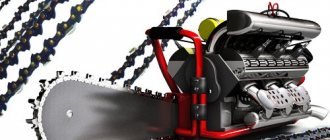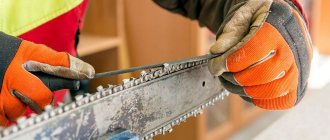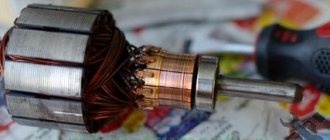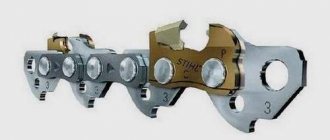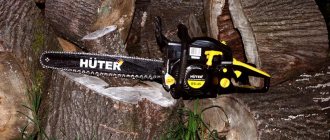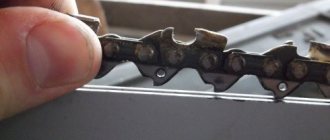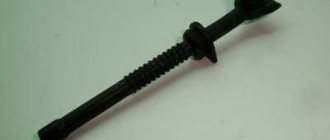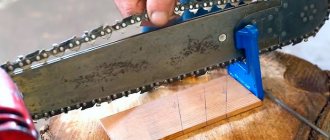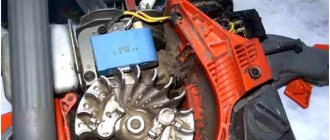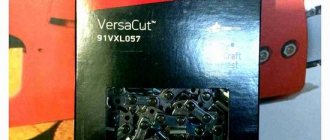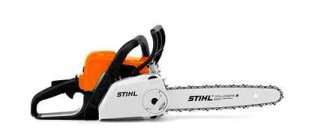What types of chainsaw chains are there?
Today the market is filled with many varieties of saw elements. They are divided according to their characteristics and are divided into several categories.
According to the type of sawing direction, the following types of parts are distinguished:
- transverse - a saw set of this type is characterized by the effect of smoothing vibration and reducing the load on the tool’s engine. This makes using the saw easier and more convenient;
- longitudinal – parts of this type are distinguished by their high performance.
Another important characteristic is the pitch of the chainsaw chain.
Based on this factor, saw sets are divided into the following types:
- 0.25 or 1/4" - these parts are equipped with one-handed household saws;
- 0.325 or 3/8" - elements with this pitch are most often equipped with semi-professional tools;
- 0.404 or 3/4" - such parts are suitable for use on concrete or aerated concrete.
As a rule, the performance of the headset directly depends on the step.
The third characteristic is the thickness of the shanks. To install the element, this parameter must match the dimensions of the grooves in the tool tire. This way, the headset will be firmly fixed to the tire, and the risk of it accidentally slipping off will be minimized.
The following types of parts are available for sale:
- chains with a shank thickness of 1.1 mm - these parts are used for working with household tools;
- elements whose shank thickness is 1.3 mm - this type of headset is used to equip semi-professional chainsaws;
- products whose shank thickness is 1.5 mm are used for regular equipment of small but powerful household tools;
- parts whose shank thickness ranges from 1.6 to 2 mm - this set is mounted only on powerful industrial saws.
Many experts also divide the working parts according to the possibility of installing them on chainsaws with a self-sharpening function. Based on this property, there may also be a self-sharpening headset or chain on sale that needs to be sharpened by hand.
Manual method
This is the simplest and slowest method for sharpening chain teeth. However, the method is good when sharpening is done on site in the forest. Why not carry a whole machine with you all the time?! But here it’s worth being more precise - we don’t mean one tool, but a whole set, which includes:
- flat file;
- round file;
- sample.
Each of them performs their duties. The main purpose of the flat tool is to sharpen the depth gauge.
A round file already performs the main operation, making the cutting edges sharper. In this case, each chain requires a certain tool diameter:
- pitch ¼ inch - 4 mm;
- pitch 0.325 – 4.8 mm;
- pitch 3/8 inch - 5.2 mm;
- pitch 0.404 - 5.5 mm.
For Picco chains, which are equipped with Shtil 180 chainsaws with 3/8 and quarter inch pitches, a file with a diameter of 4 mm is also suitable. It is important to hold it correctly. With respect to the vertical plane, the file must be positioned strictly perpendicular to the chain, and with respect to the horizontal plane - at a slight angle (about 30°). The specific sharpening angle is selected depending on the needs, but within 25-35°.
Unlike sharpening a chainsaw chain on a machine, the angle here can be set using a template, which is considered a useful assistant. For this purpose, it is equipped with two slots: SOFT/S (for soft wood) and HARD/H (for hard wood). The template must be secured above the chain, which gives it the privileges of a limiter.
Read also: What to make a reverse hammer from
Just keep in mind that this method is not intended for permanent use, but serves only as a straightening of the blades. Using a file too often will wear out the chain over time, and the teeth themselves will be sharpened unevenly.
How to choose a chain for a chainsaw?
Studying several important factors will help a beginner choose a chain for a chainsaw.
Their list includes:
- headset material – the most reliable products will be those manufactured using high-alloy steel made with nickel and chromium. To be able to saw particularly hard wood, it is best to choose a headset with pobedit tips. It is important to take into account that the Pobedit chain for a chainsaw is heavy, so it should only be installed on a tool with high power. The material from which the part is made will be indicated by the markings on its cutting teeth;
- number of links - the efficiency of the product depends on this parameter. To determine the number of elements, you need to count the teeth of the saw set;
- cutting depth - this parameter depends on the height of the chain tooth profile. Today, customers can choose one of two options - parts with a tooth height of 0.635 mm or products with a tooth height of 0.762 mm. Products of the first type are used to complete household saws. Elements of the second type are installed on powerful semi-professional and industrial tools;
- chain length - directly depends on the size of the saw used. Suitable headset dimensions are usually indicated in the operating instructions for the instrument;
- direction of sawing - the buyer will need to determine in advance exactly how he will cut the wood - lengthwise or crosswise. In each of these cases, different types of headsets are used.
In the event that the buyer cannot independently determine the pitch of the chainsaw chain or its other important parameters, then you can use the available chain selection table for popular chainsaws.
Mechanized sharpening on a machine
Special tools that can be used to simplify the procedure have become quite widespread. Such machines are equipped with a special electric drive and grinding wheels with increased wear resistance.
A small tool is suitable for use at home. Such devices can be powered from a 220 V network, and the power consumption is 100 W. Installing a chain is quite simple; the sharpening procedure can be carried out even without special training.
When choosing a machine, pay attention to the following points:
- Adjustment of the sharpening angle within a certain required range.
- Possibility of processing chains with different pitches and cutting edge thicknesses.
- Features of the procedure for changing grinding discs.
- Control of the cutting width value.
- Power of the installed electric motor and energy consumption indicator.
In addition, it is recommended to pay attention to the popularity of the brand, since service life and many other aspects depend on this.
In conclusion, we note that mistakes made at the time of sharpening can cause increased chain wear. That is why, if you use a tool frequently and do not have a sharpening machine required, it is recommended to entrust the work to professionals who provide the appropriate services.
If you find an error, please select a piece of text and press Ctrl+Enter.
A chainsaw is a necessary tool for household needs; it can find worthy use in the countryside. A chainsaw is easy to cut wood for a stove or fireplace. It also performs well when felling trees. Every owner of such an assistant should know the correct angle for sharpening chainsaw chains. Calling a specialist to your home, and especially to your dacha, costs a lot of money. Therefore, you have to make do on your own.
Read also: How to make a large hole in metal
Although it is better to entrust sharpening to a professional, some lumberjacks have learned this craft on their own. If wood cutting specialists have to sharpen a chain 3-4 times a day, then an ordinary gardener does not have such a need due to the fact that he rarely uses the tool. How can you master the craft yourself? There are some recommendations for this.
How to properly tension a chain on a chainsaw?
Tensioning the chain on a chainsaw can be done in two ways.
These include:
- the traditional method of tensioning with a tool - to install the chain on a chainsaw you will need a standard wrench, which is almost always supplied with a gasoline saw. The first side of the wrench is the working side, which is used to unscrew the nuts. The other side of the key is a slotted screwdriver. To properly put the chain on a chainsaw, you must first loosen the nuts that are located on the cover that covers the place where the standard bar is fixed. The main thing is not to rush, and slowly tighten the headset, regularly checking it with your hands. To do this, you need to lightly pull the part at the bottom of the factory tire with one hand. After adjustment, all that remains is to tighten the nuts in the cover;
- tensioning without tools - with this method, installing a chain on a chainsaw will be easier and faster. To do this, there is a factory tensioner on the side of the saw. By rotating it, the operator will be able to control the position of the headset on the bus.
As soon as the installation of the chain on the chainsaw is completed, you will need to check it. With optimal tension, the headset will not sag at the bottom. If you pull the chain away from the bar, the internal teeth of the part should come out of the grooves of the standard bar by about 5 mm.
It is important to understand which side to place the chain on the chainsaw. For this purpose, you will certainly need to study the instructions in the operating instructions for the tool.
How to shorten a chainsaw chain with your own hands?
Many beginners do not always know what to do if the chain on a chainsaw stretches. Shortening the headset by one or more links will help solve the problem.
To rivet the chain you will need the following tools:
- vice;
- hammer;
- anvil;
- sandpaper;
- grinder and diamond grinding attachment in the shape of a circle;
- thin bureauc.
You can also rivet a chain with a device called a punch.
There are several types of such machines:
- chain rivet punch – this tool is used exclusively for removing excess rivets. For this purpose, the punch is equipped with an anvil with grooves for installation. To remove rivets, the punch comes with several pairs of replaceable tips;
- riveting-rolling machine - after removing the excess link, you will need to install a new one and re-rivet the headset. For these purposes, a riveting-rolling machine is used. This chain riveter is equipped with an electric motor that produces high torque. When working with the machine, the cutting depth can be from 1.1 to 2 mm. The delivery set of the riveter includes various carbide anvils and inserts, which rotate at different speeds during operation of the equipment.
If the owner of the saw does not have the opportunity to purchase machines, then you can shorten the chain on the chainsaw using available tools.
The repair looks like this:
- First, the stretched link will need to be carefully sanded down with sandpaper. In this case, you need to try not to damage neighboring links;
- Next, the damaged link will need to be ground off with a grinder.
- After this, the remaining elements need to be turned out. In this case, the chain guides must be clamped with a vice. This will make it possible to carefully cut off the rivets that are located on the standard connecting link.
After riveting, the headset must be placed between the plastics of the connecting link of the bits, and sharply hit with a hammer.
After this, the plates should detach from the factory rivet. Before you rivet the chainsaw chain, you need to buy a repair link. When choosing it, you will need to take into account the type of headset, pitch and its profile. To properly rivet the element, it will need to be placed on an anvil. In this case, its open part should be directed upward. Then you need to put the top plate on the rivets and lightly tap it with a hammer. Next, you can begin flattening the factory rivets.
At home, this is done in this order:
- The chain must be placed on the anvil, and the bit must be placed on the rivet of the headset;
- After this, you will need to sharply hit the parts with a hammer. The same must be done with the second rivet;
- Finally, you will need to make sure that the headset link moves freely when the chain rotates.
If shortening the chain with your own hands was done incorrectly, as a result of which the repair link does not move, then such a set cannot be used for sawing. It may rupture during operation and cause serious injury to the operator.
Popular manufacturers
The modern market is full of offers from manufacturers. But there are companies that are time-tested. It is their products that are preferred by owners of circular saws. A short list of popular brands is as follows:
CMT. The company appeared in Italy back in 1962. Production was moved to China, and only the head office remained in Europe.
"Makita". The year the company was founded was 1915. Much time has passed since then, but Japanese products are still popular all over the world.
"Bosch". This name has long been a symbol of unsurpassed quality. Saw blades under the Bosh brand are welcome guests in every home workshop.
"Attack". The organization appeared in 1998 in Russia. It can rightfully be called the oldest supplier of consumables on the domestic market.
Metabo. The name comes from the German name for a hand drill. The assembly of the first products began in Germany after 1924.
Dewalt. The company's victorious march around the planet started in the USA. Since 1922, the brand has produced accessories for power tools.
Advanced technologies are not easy to understand. Tooling manufacturers are constantly improving their production. We invite you to watch a video that will help you make the right choice and learn a lot of useful information:
How is a chainsaw chain lubricated?
Each wood sawing tool is equipped with a headset lubrication system. It is she who is responsible for supplying oil to the gears that regulate its rotation.
This mechanism consists of the following elements:
- oil reservoir - in most chainsaws it is located in the engine crankcase;
- hose - made of rubber that is resistant to oil;
- a filter that is installed near the tank;
- oil pump;
- gear that transmits the force of the chainsaw engine to the oil pump.
In order for the chainsaw chain lubrication to work smoothly, you need to know how to lubricate the chainsaw needle bearing. Oils with high density and penetration effect are best suited for this. The optimal ones would be special oils produced by Stihl and Husqvarna, the application of which requires an ordinary syringe. If you use low-quality compounds for regular lubrication, you may soon need to replace the drive roller and needle bearing.
External signs of a dull cutting edge of a chainsaw tooth
Let us recall that a chainsaw tooth has a complex configuration (see Fig. 1), which also depends on the direction of movement of the chain. It has two working edges: a side edge, which is located perpendicular to the axis of movement of the links, and an upper edge, located at a certain angle to the direction of movement of the chain. In addition, a limiter is provided on each tooth, the parameters of which determine the height of the chips removed. Since the main cutting force falls precisely on the working angle, all subsequent work with the tool will depend on the angle to which the tooth is sharpened.
Figure 1 – Functional parts of a chainsaw tooth and their appearance
Before starting long-term work with a chainsaw, it needs to be inspected and test sawed, as a result of which:
- Visually determine the presence (or absence) of a conical section adjacent to the corner of the tooth, as well as a radius rounding on it - the main signs of blunting (see Fig. 2).
Read also: How to lubricate a Stihl chainsaw chain
- Check the feed force at which the tool operates steadily and produces a quick cut. For sharp teeth, the initial moment of penetration of the tooth into the wood occurs quickly, and without significant resistance to the material.
- Find out the presence of chain vibrations during a steady cut - if they are noticeable, then the teeth need to be sharpened.
- Inspect the appearance of the newly cut end (especially if the tool is used for rip sawing). If there are rough chips and dents, the chainsaw chain must be sharpened.
How does a chainsaw chain lubrication system work?
The chainsaw is constantly lubricated by an oil pump. The oil hose ends at the point where the bar connects to the crankcase of your existing chainsaw. In turn, the chainsaw headset has a hole or grooves through which the standard oil is dispersed throughout all working parts.
The design and operating principle of the lubrication systems used in modern chainsaws is distinguished by its simplicity. This makes it possible for every owner of a gasoline tool to repair the mechanism.
